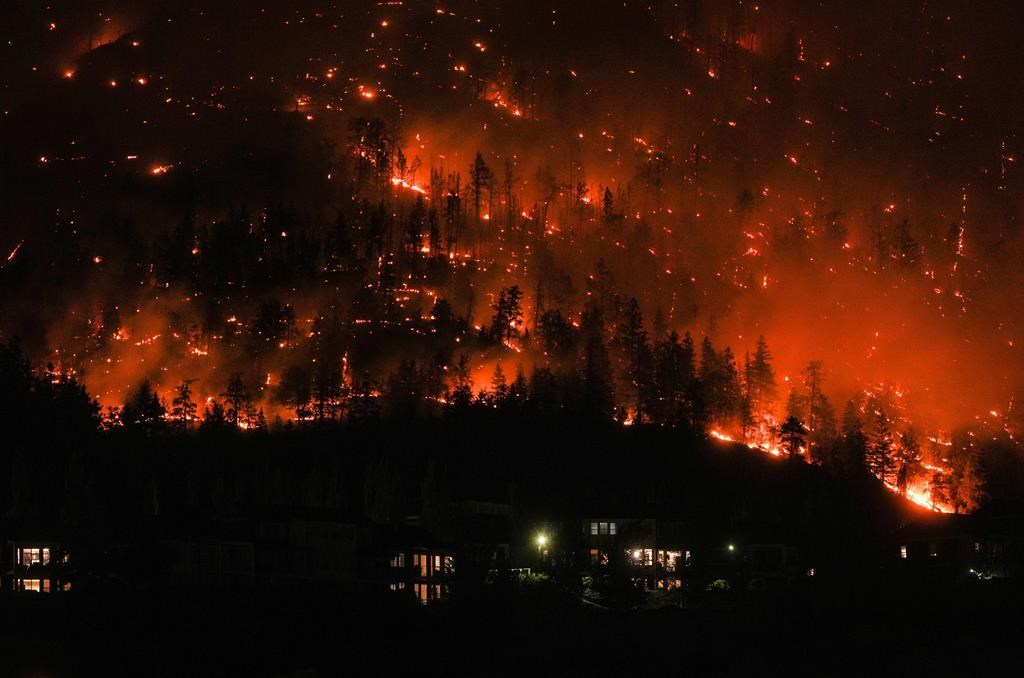The charred hills surrounding Okanagan Lake in B.C.’s Interior will likely look very different in a year’s time and beyond as life returns to the wildfire-ravaged landscape, ecologists predict.

An eruption of low plants, grasses, and shrubs will turn the hills green. Birds and small mammals, as well as deer and bears, will return to feast on berries and other plant life. Carnivores including cougars could move in.
But the tall trees destroyed by the fires may never recover or return, said Robert Gray, a wildland fire ecologist.

“When you look at West Kelowna, it’s really rocky, steep ground and trees aren’t going to come back very well there. There is not a lot of moisture in the soil and it’s only going to get drier with climate change,” said Gray.
“A lot of that landscape may not see a lot of trees come back.”
Gray said that by next June, people should expect to see “an explosion of shrubs, grasses, and herbs” sprouting from the ruined forest.
“What will happen on that landscape is you’ll get a lot of shrubs. Grasses will come back and that’s good for a while,” said Gray.
“Nature is amazing. It’s resilience … there are so many plants that are adapted to fire. They need fire on a regular basis, so they will re-occupy those areas,” said Gray.

For instance, shrub species in the wildfire zone already had seeds deeply buried in the soil, and were waiting for heat or fire to germinate them, Gray said.
Tree recovery is a different matter.

Get daily National news
“Unless you intentionally plant these areas, they’re not likely to have a lot of trees in the future,” said Gray.
Okanagan residents are no strangers to catastrophic wildfires.
In 2003, the Okanagan Mountain Park fire forced the evacuation of thousands of people and destroyed 239 properties. It also transformed the landscape.
Tara Bergeson, an urban forestry supervisor with the City of Kelowna, said the 2003 fire that scorched the park and the city was “very severe and has had a lasting impact on the landbase.”

“Little regeneration has occurred in much of the area, and we may not see trees return in a timely way or at all. Currently, much of the area remains as shrubs and grassland,” Bergeson wrote in an email.
Recently burned trees, weakened but clinging to life, can attract bark beetles and other insects, Gray said.
“These little beetles, they’ll burrow into the tree and they will lay their eggs, and when the young larvae grow they will basically kill the tree,” said Gray.
In about five to eight years, dead trees will start breaking apart.
Gray said situations like these will pose significant fire risks, especially with ongoing climate change making things drier and hotter. He said prescribed burns would be important in such areas to limit future wildfires.

Ken Lertzman, professor emeritus at Simon Fraser University’s School of resource and environmental management, said some small animals can thrive after fires, such as bluebirds, hawks, owls and woodpeckers.
“They can really take advantage of that particular mix of resources that are available in those very young, open forests,” said Lertzman.
Gray agreed, saying recently burned, open forest ground with plenty of grasses and shrubs could be a food heaven for animals.
“Now it’s open and there are grasses and herbs and shrubs and berries and nuts, there is so much to eat,” said Gray.
A diverse shrub community with berries would attract visitors including deer, elk and bears, and insects and birds would be drawn to flowers, added Gray.

Lertzman said the length of forest regeneration depends on many factors, ranging from soil conditions to temperatures.
Generally, it takes 40 to 60 years for young forests to get established and at least 100 years for mature forests to return, said Lertzman, adding that forests recovering from fire represented a natural cycle.
“In the B.C. Interior and lots of forests around the world, the forest fire is part of the evolutionary history of the forest,” said Lertzman.
However, Gray said it would not necessarily be a bad thing if many trees did not come back.
“If we get the similar forest back, then it will just burn again,” he said.
“On that landscape, you definitely want fewer trees because the more trees, you have more drought and then it weakens the trees and insects kill the trees. And then fire occurs, so we want fewer trees there.”




Comments